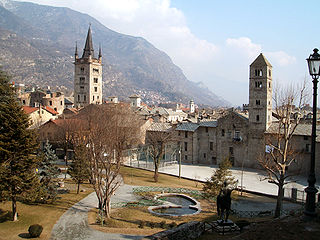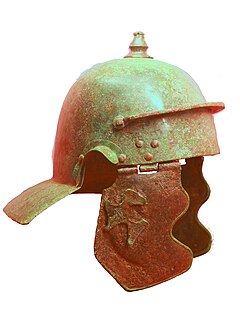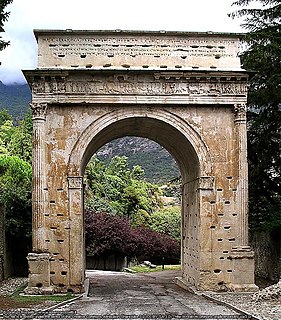
The Cottian Alps are a mountain range in the southwestern part of the Alps. They form the border between France and Italy (Piedmont). The Fréjus Road Tunnel and Fréjus Rail Tunnel between Modane and Susa are important transportation arteries between France and Italy (Turin).

Susa is a town and comune in the Metropolitan City of Turin, Piedmont, Italy. In the middle of Susa Valley, it is situated on at the confluence of the Cenischia with the Dora Riparia, a tributary of the Po River, at the foot of the Cottian Alps, 51 km (32 mi) west of Turin.

The Alpes Maritimae were a small province of the Roman Empire founded in 63 AD by Nero. It was one of the three provinces straddling the Alps between modern France and Italy, along with the Alpes Graiae et Poeninae and Alpes Cottiae. The Alpes Maritimae included parts of the present-day French departments of Alpes-Maritimes, Alpes-de-Haute-Provence and Hautes-Alpes.

The Alpes Cottiae were a small province of the Roman Empire founded in 63 AD by Nero. It was one of the three provinces straddling the Alps between modern France and Italy, along with the Alpes Graiae et Poeninae and Alpes Maritimae.

Marcus Julius Cottius was King of the Celtic and Ligurian inhabitants of the mountainous Roman region then known as Alpes Taurinae and now as the Cottian Alps early in the 1st century BC. Son and successor to King Donnus, he negotiated a dependent status with Rome that preserved considerable autonomy for his country, and adopted Roman citizenship.

The Alpes Graiae et Poeninae, later known as Alpes Atrectianae et Poeninae, were a small Alpine province of the Roman Empire created after the merging of the Alpes Poeninae and the Alpes Graiae, probably during the reign of Claudius. Comprising the modern Canton of Valais (Switzerland), the Tarantaise Valley (France), and the Val d'Aosta (Italy), it was one of the three provinces straddling the Alps between modern France and Italy, along with the Alpes Maritimae and Alpes Cottiae.
Cottii Regnum was a small independent kingdom in northwestern Italy. It included most of an important road over the pass of Mont Genevre and Mont Cenis into Gaul. The pass was in use by about 100 BC.

Exilles is a municipality in the Metropolitan City of Turin in the Italian region Piedmont, located about 60 kilometres (37 mi) west of Turin, on the border with France.

The Alpine regiments of the Roman army were those auxiliary units of the army that were originally raised in the Alpine provinces of the Roman Empire: Tres Alpes, Raetia and Noricum. All these regions were inhabited by predominantly Celtic-speaking tribes. They were annexed, or at least occupied, by the emperor Augustus' forces during the period 25–14 BC. The term "Alpine" is used geographically in this context and does not necessarily imply that the regiments in question were specialised in mountain warfare. However, in the Julio-Claudian period, when the regiments were still largely composed of Alpine recruits, it is likely that they were especially adept at mountain operations.
The Segusini were a Gallic tribe dwelling around present-day Susa, in the Alpes Cottiae, during the Iron Age.
The Caturiges were a Gallic tribe dwelling in the upper Durance valley, around present-day towns of Chorges and Embrun, during the Iron Age and the Roman period.

The Arch of Augustus is an important monument constructed in the city of Susa, Piedmont, in the province of Turin. It was originally built at the end of the 1st century BC to record the renewed alliance between Emperor Augustus and Marcus Julius Cottius, a Celto-Ligurian ruler who had been made king and Roman prefect of the Cottian Alps. The arch, together with other remains from the period, such as the Roman amphitheatre, underscore the importance that the city of Susa had during the Roman period.
The Adanates or Edenates were a small Gallic tribe dwelling around present-day Seyne, in the Alpes Cottiae, during the Iron Age.
The Belaci were a small Gallic tribe dwelling in the Alpes Cottiae, around present-day Oulx, during the Iron Age.
The Ecdinii or Ecdini were a Gallic tribe dwelling in the valley of the Tinée (Alpes-Maritimes) during the Iron Age.
The Segovii were a Gallic tribe dwelling in the Alpes Cottiae, around present-day Cesana Torinese and Montgenèvre, during the Iron Age.
The Tebavii were a Gallic tribe dwelling in the Alps during the Iron Age.
The Vesubiani or Vesubianii were a Gallic tribe dwelling in the valley of the Vésubie river during the Iron Age.
The Iemerii were a Celto-Ligurian tribe dwelling in the Val Chisone during the Iron Age.
The Gallic Alps were an ancient cultural region located in the Alps and populated mainly by Gauls. The term Celtic Alps is also found in ancient Greek texts.
2. Bartolomasi N. (1975) - Valsusa Antica - Alzani








